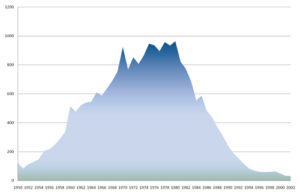Part of The Revealer’s series on the John Jay report, The Causes and Context of Sexual Abuse of Minors by Catholic Priests in the United States, 1950-2010.
by Elizabeth Castelli
Last week, two things did not happen. The Rapture did not take place on May 21, 2011, despite the fervent prognostications of a retired engineer-turned-Christian broadcaster and biblical numerologist. Meanwhile, the sex abuse scandal that has mired the Catholic Church in litigation and shame for nearly three decades was not resolved nor even really explained, despite the earnest efforts of the number-crunching social scientists at the John Jay College for Criminal Justice, City University of New York. The coincidence of these two non-happenings was more than a matter of the calendar.
For one thing, both efforts emerged out of a belief that interpreting numbers produces a useable narrative that has an explanatory power. Under the logic of this belief, the truth is but a matter of simple ciphering—whether Rapture predictions predicated on a series of simple arithmetic calculations or the purported causes of the abuse scandal in the Catholic church carefully measured, calculated, and charted with a soul-numbing statistical precision. For another, both non-events strove to package up unruly temporality with certainty and finality. In the case of Judgment Day-proclaiming Harold Camping and his Family Radio broadcasts, the focus was on the future, while the John Jay College researchers proclaimed the sexual abuse of minors by priests “a historical problem,” a thing of the past. Their discursive frames and tone may have been quite different—fiery preaching on the airwaves or the street corners, on the one hand, cold bureaucratic-speak on the pages of an executive summary, on the other—but both claimed that numbers don’t lie, and both promised that decisive temporal caesuras settle all our questions, especially those about the chaotic and ubiquitous messiness of human suffering and venality.
But there are important differences too: institutionally marginal Harold Camping is far more nimble than the United States Council of Catholic Bishops (USCCB), so that within three days of the non-event of the Rapture, he had already returned to faulty arithmetic and produced another, better date, five months hence. But the ship of the Vatican state turns far more slowly, as the researchers from John Jay themselves assert repeatedly in their report and as anyone who has followed the scandal of priestly sexual abuse already knows, and there has been no indication that the hierarchy is even aware that the John Jay report will not produce its desired result. The bishops and the church hierarchy may wish that the costly Causes and Context study has settled the matter and may indeed pretend that it has done so. But the easy resolution of the church’s abuse scandal is a bit like the prophesied end of the world—predicted and perhaps even hoped for, but inevitably deferred.
While end-time predictions will come and go, as they have from time to time since the first century, Rapture predictions and their recalculation and recalibration will continue to churn in predictable and ironic repetition, a discourse without end, amen. Meanwhile, though, the messiness of everyday life continues, and the clean temporal breaks foretold in apocalyptic thinking and expressed in the social-scientific jargon of the John Jay report will not materialize. But caught here in the ongoing messiness of everyday life, close readers of Causes and Context will find plenty of predictable and ironic repetition all their own. Historians will question the flatfooted confusion of correlation and causation, a conflation that produced the most mocked element of the report (the so-called Blame Woodstock! explanation of priestly abuse). Victims of priestly abuse and their families and advocates will wince at the suggestion that the abuse scandal should now be viewed dispassionately as “a historical problem” while the church hierarchy’s malfeasance—reduced in the report to a problem of imperfect “diffusion of innovation”—continues to escape examination or condemnation. Students of the history of Catholic thought and practice will wonder how such a monotonal and superficial account of Catholic teaching and discipline came to be enshrined in this purportedly definitive report. And fiercely loyal and disaffected Catholics alike will look upon the unimpeded moral sclerosis of the church hierarchy and mourn all the losses that deformation has produced: lost innocence, lost faith, lost moral authority, even lost life.
One might read last week’s two non-events in a generous spirit, seeing in them well-intentioned attempts to respond, however feebly and implausibly, to real-life suffering, as some commentators have argued about Harold Camping and the John Jay researchers both. But both efforts, the Rapture predictions that did not predict and the case-closing study of scandal that did not close the case, depend on the wrong affective rhetorics—rhetorics of fixity, certainty, and closure. They both try to fix the numbers and the time, but in the process they avoid the truly needed fix—the fix that actually repairs.
Elizabeth A. Castelli is professor and chair of the Religion Department at Barnard College. She is the author of Martyrdom and Memory: Early Christian Culture Making.
This article is part of The Revealer’s series on the John Jay report, “The Causes and Context of Sexual Abuse of Minors by Catholic Priests in the United States, 1950-2010.” Read additional commentary by Frances Kissling, Elizabeth Castelli, Amanda Marcotte, Scott Korb, Mary Valle and others here.



